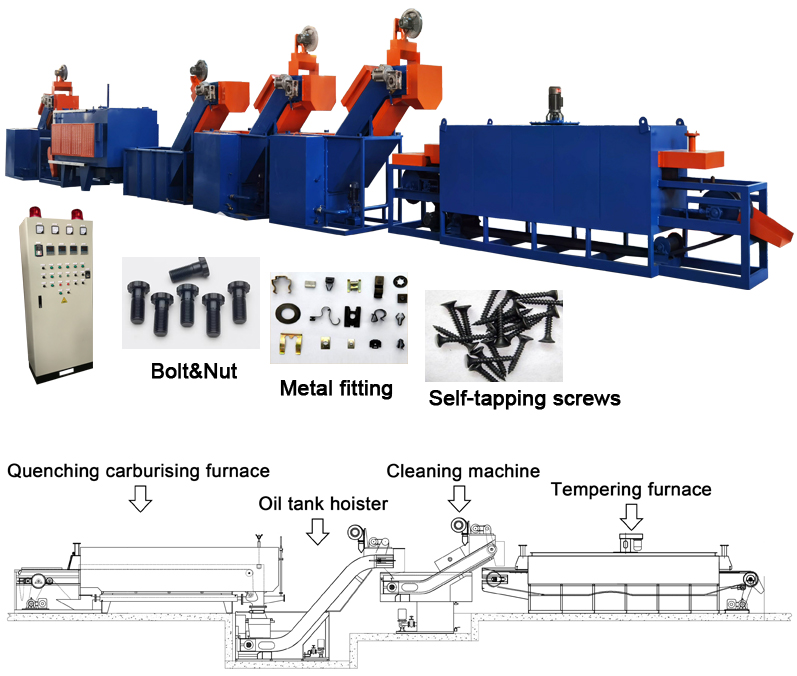What Heat Treatment Processes Are Required for Bolts, Nuts, and Washers
Jul. 12, 2025
As critical fasteners in mechanical connections, the heat treatment processes for bolts, nuts, and washers must be tailored to material type, performance requirements, and application scenarios to optimize strength, hardness, toughness, and corrosion resistance. Below is a categorized explanation of specific heat treatment processes and their purposes:
1. Heat Treatment for Bolts
Medium-carbon steel/alloy steel bolts (e.g., 45# steel, 40Cr, 35CrMo)
Process: Quenching and tempering (hardening + high-temperature tempering)
Quenching: Heat to the critical temperature (30–50°C above Ac3), hold, then rapidly cool (oil or water quenching) to form martensite for increased hardness.
Tempering: Heat to 500–650°C after quenching, hold, then air-cool to relieve internal stresses, adjust hardness to HRC 28–35, and improve toughness.
Purpose: Achieve high strength (tensile strength: 800–1200 MPa) and good toughness for high-load applications (e.g., automotive engines, bridge construction).
Stainless steel bolts (e.g., 304, 316, A2-70, A4-80)
Process: Solution treatment
Heat to 1050–1100°C, hold, then rapidly water-cool to dissolve carbides into austenite, forming a homogeneous solid solution.
Purpose: Eliminate work hardening, restore corrosion resistance, and maintain moderate strength (tensile strength: 400–800 MPa) for chemical and marine environments.
Low-carbon steel bolts (e.g., Q235, 1008)
Process: Carburizing and quenching (surface hardening)
Carburizing: Introduce carbon into the surface at 900–950°C to form a high-carbon layer (0.8–1.2% carbon).
Quenching:Rapidly cool the surface to form martensite while retaining a low-carbon martensite or ferrite core.
Purpose: Achieve surface hardness of HRC 55–60 with a tough core for wear-resistant, impact-resistant applications (e.g., mining machinery).
2. Heat Treatment for Nuts
Medium-carbon steel/alloy steel nuts
Process: Quenching and tempering (matched to bolts)
Quenching + high-temperature tempering to achieve slightly lower hardness than bolts (HRC 25–30) to prevent galling during assembly.
Purpose: Balance strength and toughness to avoid thread stripping or fracture.
Stainless steel nuts
Process: Solution treatment + aging
After solution treatment, age at 450–550°C to precipitate strengthening phases (e.g., Ni₃Ti), increasing strength to A4-80 grade (tensile strength ≥ 800 MPa).
Purpose: Meet high-strength connection demands while maintaining corrosion resistance.
3. Heat Treatment for Washers
Spring steel washers (e.g., 65Mn, 55Si2Mn)
Process: Quenching + medium-temperature tempering
Temper to 400–500°C after quenching to form tempered troostite, achieving HRC 40–45 hardness and high elastic limit.
Purpose: Provide stable elasticity to prevent bolt loosening in vibrating environments.
Stainless steel washers
Process: Solution treatment
Relieve processing stresses and restore corrosion resistance, with hardness ≤ HRC 35.
Purpose: Avoid galvanic corrosion with bolts/nuts for food or medical equipment applications.
Summary
Heat treatment processes must be comprehensively designed based on material composition, application scenarios, and performance requirements (strength, toughness, corrosion resistance). For example, high-strength bolts require quenching and tempering, stainless steel components need solution treatment, and spring washers benefit from medium-temperature tempering to optimize elasticity. Proper heat treatment significantly enhances fastener reliability and service life, making it an indispensable step in mechanical design.










